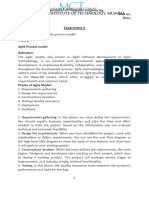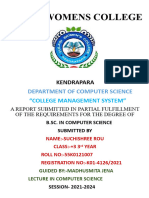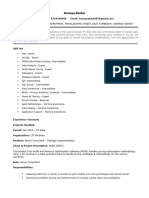Assignment 2020
Uploaded by
Mary KarmacharyaAssignment 2020
Uploaded by
Mary KarmacharyaPre-requisite module Assessment for SESE MMM 2020
Master pre-requisite module
Assignment
Question Cover.doc
CT091-0-M-SDM
SYSTEM DEVELOPMENT
METHODS
Lecturer: Ravi Rauniyar
Student Name: Mary Karmacharya
Submission Date:
Software Development Methods 1 of 2 Lecturer Name
SESE Pre-requisite Module Assessment MMM2020
Answer all questions.
Tutorial 02: SDLC Concepts and Principles
1. What is SDLC?
Ans : The Systems Development Life Cycle (SDLC) is a conceptual model used in
project management that describes the stages involved in an information system
development project, from an initial feasibility study through maintenance of the
completed application. (Wiki, 2015)
a) Explain THREE benefits of applying SDLC for a IS project.
Ans :
-Reduction of cost and time
-Improvise in quality of work
-To ensure consistency in management of project
b) Explain THREE problems of applying SDLC for a IS project.
Ans:
-Miscommunication and requirement gathering in intail phase.
-Late request and requirement of the project.
-Lack of allocated time for testing.
Software Developments Methods 2 of 2
Sivananthan
Pre-requisite module Assessment for SESE MMM 2020
c) Search the net/books and draw diagram for SDLC
Ans:
Fig : A typical Software Development Life Cycle graphical reprentation
Tutorial 03: SDLC Sub-phases
1. Use a large paper to draw SDLC
Ans:
Software Development Methods 1 of 2 Lecturer Name
Pre-requisite module Assessment for SESE MMM 2020
2. Make a summary of SDLC Main Phases and sub-phases.
Ans:
PLANNING ANALYSIS DESIGN IMPLEMENTATION MAINTENANCE
Problems Statement Designing of IT infrastructure
Initial Study Designing of system model
Feasibility Study
Requirement Gathering
Gathering business requirement Support the system users
Creating process diagrams System maintenance
Performing a detailed analysis System changes andadjustment
3. Under each Main Phases, show it’s:
a. Sub-phases
b. Who are involved?
c. Input document
d. Output documents
e. Popular Techniques used
Tutorial 03: IS Methodologies Part-1:
1. Find names of a few popular methodologies used today? What are the types of project they
used for?
Ans:
-SCRUM: Scrum is comprised of five values: commitment, courage, focus, openness, and
respect. It’s goal is to develop, deliver, and sustain complex products through collaboration,
accountability, and iterative progress.
-Kanban is another popular Agile framework that, similar to Scrum, focuses on early releases
with collaborative and self-managing teams.
Software Development Methods 1 of 2 Lecturer Name
Pre-requisite module Assessment for SESE MMM 2020
-PRINCE2 methodology is a “full stack” Waterfall project management methodology that
includes principles, themes and processes
-Waterfall methodology, often referred to as SDLC (Software Development Life
Cycle) is a project management methodology theme with a very simple approach that
values solid planning, doing it once and doing it right, rather than the Agile approach
of incremental and iterative delivery.
2. Discuss the advantages using IS Development Methodologies.
Ans:
Advantages of Waterfall Model:
Waterfall model is very simple and easy to understand and use a method that is why it
is really beneficial for the beginner or novice developer
It is easy to manage, because of the rigidity of the model. Moreover, each phase has
specific deliverables and individual review process
Advantages of Agile Development Methodology:
Agile methodology has an adaptive approach which is able to respond to the
changing requirements of the clients
Direct communication and constant feedback from customer representative
leave no space for any guesswork in the system
Advantages of the RAD model:
Rapid Application development model helps to reduce the risk and required
efforts on the part of the software developer
This model also helps client’s to take quick reviews for the project
Advantages of Scrum Development:
In this methodology, decision-making is entirely in the hands of the teams
This methodology enables project’s where the business requirements
documentation is not considered very significant for the successful development
Software Development Methods 1 of 2 Lecturer Name
Pre-requisite module Assessment for SESE MMM 2020
3. Discuss the distinctive disadvantages using the following IS Development Methodologies.
Ans:
o Waterfall model
The main drawback of this method is that once an application is in the testing stage, it
is not possible to go back and edit something
There is no possibility to produce any working software until it reaches the last stage
of the cycle
o SSADM
The disadvantage of SSADM methodology
Long development times as each stage must be completed thoroughly before moving
on to thenext. This costs time and money so organizations have to have large
resources for SSADMprojects.
Lack of user involvement means the system rarely meets user needs and is less likely
to beaccepted.
Tutorial 05: IS Development Methodologies Part-2
1. Draw a table and compare THREE differences between Traditional Methodologies with Agile
Methods.
Ans:
Charactersitics Traditional Agile
Users Not involved Frequenct collaboration
Project size big small
Requirements Clear ,low change rate Creative,unclear,
System criticality More system failure Less critical system
Software Development Methods 1 of 2 Lecturer Name
Pre-requisite module Assessment for SESE MMM 2020
2. Draw a simple diagram of the following Methodologies
Ans:
XP
Scrum
Software Development Methods 1 of 2 Lecturer Name
Pre-requisite module Assessment for SESE MMM 2020
RAD
Tutorial 08: System Analysis
1. Discuss the advantages and disadvantages of the following data analysis methods;
Ans:
Data Mining
Software Development Methods 1 of 2 Lecturer Name
Pre-requisite module Assessment for SESE MMM 2020
1. It violates user privacy:
It is a known fact that data mining collects information about people using some
market-based techniques and information technology.
Accuracy of data:
Most of the time while collecting information about certain elements one used to seek help
from their clients, but nowadays ever
Misuse of information:
As it has been explained earlier that in the data mining system the possibility of safety and
security measure are really minimal.
ything has changed.
Statistical Analysis
2. Write 2 functional and non-functional requirement for Webspace3 (upgrade of Webspace2).
Tutorial 14: System Testing
1. Explain 5 advantages and disadvantages of Software Testing.
Ans
Finding errors at the initial and final stage
Optimizing the interface errors
Checking errors or missing functions
To check and verify the errors in the external dat
It helps to optimize the whole internal source code as the tester is having
programming knowledge
Almost all paths of a software product will be covered
As the tester is having programming knowledge it will be easy to find out the
inappropriate unit code
Disadvantage
Only limited coverage of application as the tester cannot target specific code
segment
Test cases are difficult to design as the tester doesn’t have prior knowledge on
specifications and coding
Some possible inputs will only be tested
There may be a chance of occurring redundant if the designer already starts
the test case
Software Development Methods 1 of 2 Lecturer Name
Pre-requisite module Assessment for SESE MMM 2020
Results will be more efficient but according to resources it may become
expensive
2. Find 3 Testing Tools (software) which can be used to test other software.
3. Apache JMeter
It is an Open Source load testing tool, scripted in Java 6+ and can operate across platforms.
Apache recently released JMeter ‘v2.11’ that supports all platforms and is used for load testing to
analyze and gauge performance of the system/application.
Its strong GUI helps build Test Plan quickly and debug processes. It further helps analyze the
overall performance under various loads on the server, and the network.
14. Sandstorm
It is a load testing tool from Impetus Technologies Inc. that supports protocols for the Web,
Mobile and Email. It facilitates test from multiple locations, across browsers and simulates cache
with rich extensible framework for modification of test cases by using JavaScript and core Java
APIs.
It provides User Interface for handling dynamic parameters and automated cookies. It also
integrates resource monitoring for most of the popular Web applications and Database servers.
NeoLoad
This is a load and stress testing tool by Neotys built for Windows, Linux, and Solaris. It is available
in English and French, and its latest version 4.2 helps measure, analyze, and improve the
performance of the website.
Software Development Methods 1 of 2 Lecturer Name
Pre-requisite module Assessment for SESE MMM 2020
While there are multiple users simultaneously accessing the website, the tool helps check the
performance of the website under added load to ensure required user experience. It makes the
testing process faster, efficient, and repetitive.
4.
Software Development Methods 1 of 2 Lecturer Name
You might also like
- Bit 3201 Object Oriented Analysis and Design Assignments - Docx BKPNo ratings yetBit 3201 Object Oriented Analysis and Design Assignments - Docx BKP4 pages
- Latar Belakang System Development Life Cycle Perkembangan System Development Peran Life Cycle Management Dalam PerusahaanNo ratings yetLatar Belakang System Development Life Cycle Perkembangan System Development Peran Life Cycle Management Dalam Perusahaan22 pages
- Proposed Model To Overcome The Problems in Waterfall Model: ABSTRACT - in This Paper, I Have Reviewed The ModificationsNo ratings yetProposed Model To Overcome The Problems in Waterfall Model: ABSTRACT - in This Paper, I Have Reviewed The Modifications4 pages
- Systems Development: Phases, Tools, and TechniquesNo ratings yetSystems Development: Phases, Tools, and Techniques59 pages
- Complete Edited Ijeoma Chapter Three GoodNo ratings yetComplete Edited Ijeoma Chapter Three Good15 pages
- This Assignment Consists of TWO (2) Questions. Answer The QuestionsNo ratings yetThis Assignment Consists of TWO (2) Questions. Answer The Questions10 pages
- SE Unit-2 SDLC & Software Process ModelsNo ratings yetSE Unit-2 SDLC & Software Process Models16 pages
- Assignment 2 May 2021 Semester: There Are Two (2) Pages of Questions, Including This PageNo ratings yetAssignment 2 May 2021 Semester: There Are Two (2) Pages of Questions, Including This Page8 pages
- Software Testing Interview Questions You'll Most Likely Be AskedFrom EverandSoftware Testing Interview Questions You'll Most Likely Be AskedNo ratings yet
- Chapter 5 - 7 Eleven Case Studies - QuesNo ratings yetChapter 5 - 7 Eleven Case Studies - Ques3 pages
- Full - Final - Development That - Pays - Review PDFNo ratings yetFull - Final - Development That - Pays - Review PDF9 pages
- MSU-Sulu ROTC Enrollment System Chapter 1-3No ratings yetMSU-Sulu ROTC Enrollment System Chapter 1-321 pages
- MIS & DSS - Solutions To Previous Year Questions100% (1)MIS & DSS - Solutions To Previous Year Questions57 pages
- More On Adding Threat During Software Requirements Elicitation and PrioritizationNo ratings yetMore On Adding Threat During Software Requirements Elicitation and Prioritization5 pages
- 1 - Motivation and Need For Software Process ModelNo ratings yet1 - Motivation and Need For Software Process Model48 pages
- Software-Testing-Quality-Assurance (Set 1)No ratings yetSoftware-Testing-Quality-Assurance (Set 1)21 pages
- Organizational Frameworks Learning Over TimeNo ratings yetOrganizational Frameworks Learning Over Time24 pages
- Chapter 4 - Requirement Modeling (CS31)No ratings yetChapter 4 - Requirement Modeling (CS31)45 pages
- Different Types of Risks in Software Project Development - GeeksforGeeksNo ratings yetDifferent Types of Risks in Software Project Development - GeeksforGeeks6 pages
- CSC2073 - Lecture 03 (Software Process, Waterfall Model)No ratings yetCSC2073 - Lecture 03 (Software Process, Waterfall Model)17 pages
- General Cargo Operations Management System GCOMS100% (1)General Cargo Operations Management System GCOMS25 pages
- Bit 3201 Object Oriented Analysis and Design Assignments - Docx BKPBit 3201 Object Oriented Analysis and Design Assignments - Docx BKP
- Latar Belakang System Development Life Cycle Perkembangan System Development Peran Life Cycle Management Dalam PerusahaanLatar Belakang System Development Life Cycle Perkembangan System Development Peran Life Cycle Management Dalam Perusahaan
- Proposed Model To Overcome The Problems in Waterfall Model: ABSTRACT - in This Paper, I Have Reviewed The ModificationsProposed Model To Overcome The Problems in Waterfall Model: ABSTRACT - in This Paper, I Have Reviewed The Modifications
- Systems Development: Phases, Tools, and TechniquesSystems Development: Phases, Tools, and Techniques
- This Assignment Consists of TWO (2) Questions. Answer The QuestionsThis Assignment Consists of TWO (2) Questions. Answer The Questions
- Assignment 2 May 2021 Semester: There Are Two (2) Pages of Questions, Including This PageAssignment 2 May 2021 Semester: There Are Two (2) Pages of Questions, Including This Page
- Defect Prediction in Software Development & MaintainenceFrom EverandDefect Prediction in Software Development & Maintainence
- Software Testing Interview Questions You'll Most Likely Be AskedFrom EverandSoftware Testing Interview Questions You'll Most Likely Be Asked
- Full - Final - Development That - Pays - Review PDFFull - Final - Development That - Pays - Review PDF
- More On Adding Threat During Software Requirements Elicitation and PrioritizationMore On Adding Threat During Software Requirements Elicitation and Prioritization
- 1 - Motivation and Need For Software Process Model1 - Motivation and Need For Software Process Model
- Different Types of Risks in Software Project Development - GeeksforGeeksDifferent Types of Risks in Software Project Development - GeeksforGeeks
- CSC2073 - Lecture 03 (Software Process, Waterfall Model)CSC2073 - Lecture 03 (Software Process, Waterfall Model)































































































